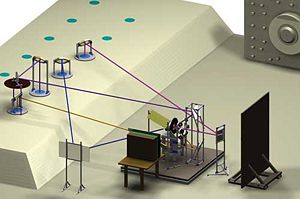Flash radiography
Flash radiography is a technique to photograph objects moving at extremely high speed, such as in explosions, to allow the measurement of "their position, speed, shape, and internal density profiles...radiographic images are used to validate computer models and to experimentally determine material parameters in transient interactions, including high temperature and pressure regimes." While it has dual-use civilian applications, it is a technology critical to the development of nuclear weapons and advanced conventional explosives.
• Key elements of flash radiography are the illumination source (X-rays or protons), an experimental configuration which contains the blast and debris from dynamic experiments, a high resolution and quantum efficiency detection system to record the radiographic image, and analysis software to interpret the image into physically useful information.[1]
Conducting these tests require a diverse range of skills including physics, photography, and materials science. The test specialists, in the U.S., are informally called "ramrods". [2]
X-ray
A computer-aided design layout shows placement of the experiment, which is surrounded by mirrors on stands, flashlamps, and a radiographic film cassette. Extremely energetic x rays emerge from the Flash X Ray machine through a port (upper right). Behind the experiment is the protective enclosure for radiographic film. Images from a series of mirrors are reflected to four optical cameras, providing different viewpoints. Each optical path is indicated by a different color. The cameras are located directly below the four ports on the left.
Linear induction accelerators (LIAs) can produce ~ kA electron beams, transported through the length of the accelerator and focused to create a small radiographic X-ray source spot for point-projection illumination. State-of-the-art capabilities for a single axis are: ~ 20 MeV single pulse, 500 R dose at 1 m in 60 ns from ~ 2-mm spot.
Pulsed power accelerators operate at lower energy (~ 14 MeV) but can produce single pulse ~ 100 kA focused electron beams to create X-ray doses equivalent to those of LIAs for the same application. Pulsed power-driven X-ray spot sizes are larger than from LIAs, but are approaching equivalent capabilities.
• High intensity laser beams have been shown to be capable of accelerating electrons to very high energies (100 MeV) and producing very high intensity flash X-ray sources on the order of ten micron spot size suitable for a wide array of radiographic applications.
Proton beam
Proton radiography (pRad) utilizes conventional high energy accelerator technology to provide bursts of higher kinetic energy (1–50 GeV) protons distributed uniformly across objects to create flash radiographs of equivalent mass-profile information to the best flash X-ray radiographs
References
- ↑ Under Secretary of Defense, Acquisition, Technology and Logistics Pentagon, VA (June 2009), Section 15, Nuclear Systems Technology; Section 15.1, Flash Radiography, Militarily Critical Technologies List, U.S. Department of Defense
- ↑ "Ramrods Shepherd Hydrodynamic Tests", Science and Technology Review, Lawrence Livermore National Laboratory, September 2007
